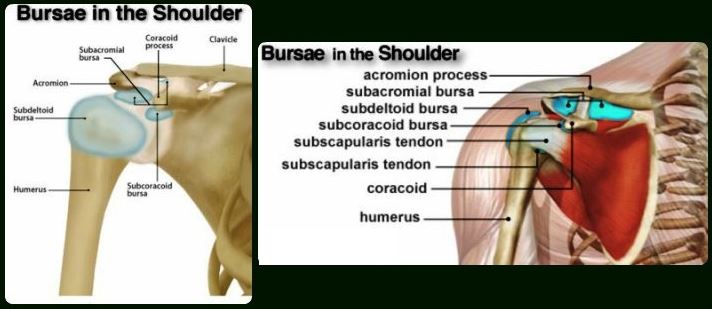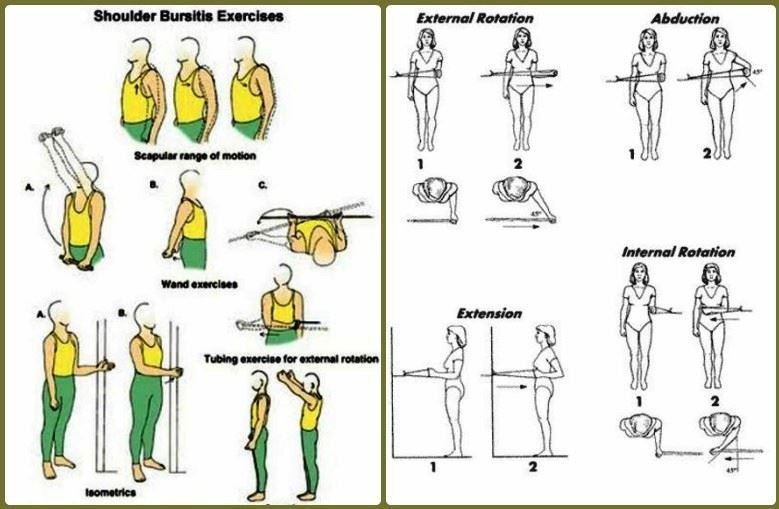Shoulder Bursitis
What is shoulder bursitis?
Shoulder bursitis is the clinical condition where bursa present is shoulder joints become inflamed due to any injury. Bursa is an anatomical sac like structure filled with fluid, present in the adjacent part of the gliding surface of the joint. Around 160 bursae (plural of bursa) are present mainly in the larger joints such as shoulder, hip, knee and elbow joint of the human body. They help to reduce the friction between bones and adjoining tendon during movement.

Symptoms of shoulder bursitis
The most common symptoms of the shoulder bursitis are as follows:
Pain in the shoulder joint
The most prominent symptom of shoulder, bursitis is pain. The onset of pain may be gradual or sudden. The intensity of the pain is increased with time in case of gradual pain symptom. The time may differ from one week or even month to reach severe pain syndrome.
In case of sudden onset intensity of pain is already elevated due to deposition of the calcium. Pain is extended from the shoulder to the external surrounded tissue also. Sometimes pain spread to the elbow and wrist joint. Even affected upper limb may have pain due to shoulder bursitis.
Pain becomes worsen due to some postural change like lying down on the affected side or keep hands on the upper position of the head. The activities such as head wash and arranging upper shelves of the cupboard become difficult. The shoulder pain is felt during stretching or moving of the affected hand at the 600 or 900 . Pinching pain felt during elevation of the elbow joint. Pain intensity becomes mild during keeping the affected hand towards side of the body or above 900 positions.
Frozen Shoulder
Loss of shoulder joint mobility is termed as ‘frozen shoulder’ or ‘adhesive capsulitis’. Popping or crunching during movement of the shoulder joint. Weakness develop in the shoulder joint.
Causes
The possible reasons for bursa inflammation are injury, infection, joint disorder or onset of rheumatic condition. Injury occurs may be due to continuous mild forces or stern rapid trauma.
Age is another considerable factor. With increasing age, tendons which help to connect the muscle with bones, lose elasticity, stress tolerance power and easily tear able. Occupational hazards, including gardening, carpeting, scrubbing, painting, raking or sports activities like tennis, golf, throwing, skiing etc. are causing over activity of the shoulder joint.
Sudden lifting of heavy luggage or before conducting proper warm up strenuous exercise steps or stretching and poor posture during working or lying can cause shoulder bursitis.
Concurrent medical conditions such as thyroid gland malfunction, rheumatoid arthritis, gout, psoriatic arthritis increase the risk of shoulder bursitis.
Diagnosis
The initial diagnosis is started with physical examination of the shoulder joint and also discussion of sign and symptoms, accidental incidence or work activities.
The possible tests may ordered by a healthcare provider which help to further diagnosis of shoulder bursitis.
Blood test
Presence of infection can be diagnosed by blood test and also other factors such as rheumatoid arthritis, gout, calcium level in the blood are also evaluated by conducting blood test.
X- Ray
The X-Ray helps to diagnose the positioning of the bone, presence of fracture or any other reason which causes pain in the shoulder. In case of recurrence or chronic shoulder bursitis, calcifications can be detected by X-ray.
MRI
MRI scanning helps to detect shoulder bursitis, as it helps to show the tissue damage. Sometimes for more prominent image contrast dye is used. But if patient having any hypersensitivity against the dye, then consult it before the examination begins.
Fluid culture
For more specific identification of the causative agent of the infection, small amount of fluid from bursa is injected out and carried out different laboratory tests.
Treatment
The available treatment for shoulder bursitis are divided into two categories
Pharmacological therapy
- Non-steroidal- anti-inflammatory drugs (NSAIDs)
To reduce the pain symptoms and inflammation, doctors initially prescribed NSAIDs. Strictly follow the instruction, as this category of medications provides side effects as gastrointestinal ulcer or renal problem.
- Antibiotics
If shoulder bursitis occurs due to bacterial infection, then antibiotics help to kill or static the growth of the bacteria which causes infection and the condition is treated.
- Steroidal injection
In case of severe pain and inflammation, which cannot control by NSAIDs, then steroidal injection may doctors prescribed to lessen the pain and inflammation. But long term therapy should be avoided, as steroidal drugs have long term side effects.
Surgical intervention
- Bursectomy is specific surgical intervention, conducted in case of failure of other treatment. During this surgery affected bursa is removed from the affected joint.
Exercises
Performing certain exercise steps help to accelerate the healing of shoulder bursitis along with combination of medications prescribed by the doctor or adequate rest and cold and hot compression. These also prevent the development of the shoulder bursitis.

- Push up against wall: for this stand with keeping short distance from the wall and then place the palm on the wall with maintain the shoulder height and width. Then pushing the palm against the wall without hip bending into a forward direction. After that, push back up. Repeat this for 15 to 20 times.
- Low weight lifting: Sit on a chair, hand should be side of the body. Hold a light weight (pain should not be increased) and lift the hand up to shoulder level and then again down the hand position.
- Shoulder movement: Lie straight on the flat surface with front facing direction. Then slowly raise hands towards the roof and palm should be faced with each other. Gradually move the hands towards an upper head position as much possible and without bending back. Try to keep the elbow at the side of the ear. Hold the position for 30 seconds and then relax, repeat this for 8 to 10 times. This gradually helps to improve mobility of the shoulder joint.
References
- http://www.medicinenet.com/shoulder_bursitis/page2.htm
- http://www.webmd.com/pain-management/arthritis-bursitis
- What is Rotator Cuff Impingement Syndrome? at http://physioworks.com.au/injuries-conditions-1/bursitis_shoulder
- http://www.orthopaedics.com.sg/conditions/shoulder-pain/shoulder-bursitis
- How is shoulder bursitis treated? prevention, management at http://www.drugs.com/cg/shoulder-bursitis.html
- Exercises for Bursitis in the Shoulder at http://www.livestrong.com/article/120185-exercises-bursitis-shoulder/
